Pentaho Assessment Report
This topic contains information about the Pentaho assessment report. The assessment assesses workloads and produces in-depth insights that help plan the migration. The input format for Pentaho assessment is KJB and KTR file formats.
In This Topic:
Highlights
The highlights section gives you a high-level overview of your assessment summary of the analytics performed on the selected workloads. It includes information about the components, steps, and queries.
Summary
This section summarizes the input Pentaho scripts analyzed at job and transformation level. It includes information about files, jobs, transformations, queries, and entities.

- Files: Displays the number of source files.
- Jobs: A job is a set of tasks that control the system for scheduling, monitoring, and reporting. It can be in the form of command, file, or script.
- Transformations: Transformation is a process of moving and transforming workloads from source to target.
- Queries: Displays the number of queries.
- Entities: Displays the number of entities.
Jobs
This section showcases an overview of active and inactive components existing in the source file along with their complexity.
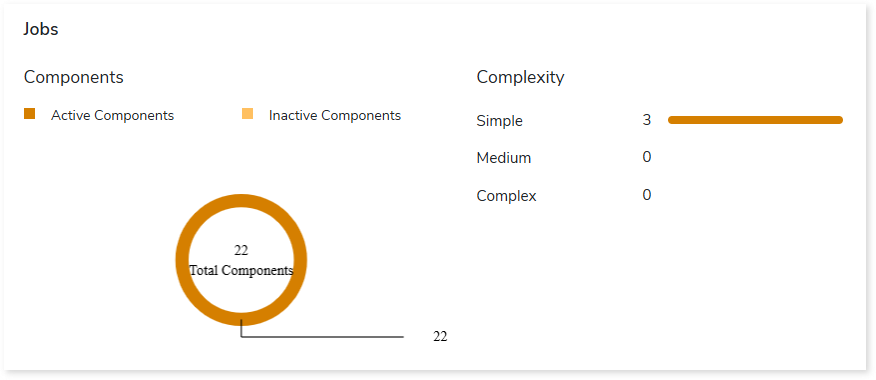
- Total Components: Displays the total number of components in the jobs.
- Active Components: Displays the number of components in the jobs that are engaged in the dataflow.
- Inactive Components: Inactive elements or the components that are not engaged or used in the source files. Displays the number of components in the jobs that are not engaged in the dataflow.
- Complexity: Displays the complexity of jobs.
Transformation
This section showcases an overview of active and inactive steps along with their complexity.

- Total Steps: Displays the total number of steps in the transformation.
- Active Steps: Displays the number of steps in the jobs that are active in the dataflow.
- Inactive Steps: Displays the number of steps in the jobs that are inactive in the dataflow.
- Complexity: Displays the complexity of transformations.
Queries
It displays a synopsis of analyzed queries along with information about unique, parsed, and unparsed queries.
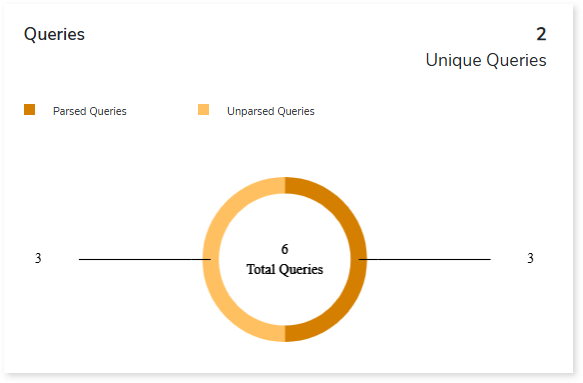
- Total Queries: Displays the total number of queries.
- Unique Queries: Displays the number of unique queries. In Unique Queries, the duplicate queries are eliminated, and solitary queries are identified.
- Parsed Queries: Displays the number of parsed queries.
- Unparsed Queries: Displays the number of unparsed queries.
Query Complexity
This section provides an overview of query complexity distribution for parsed queries within the source ETL files.
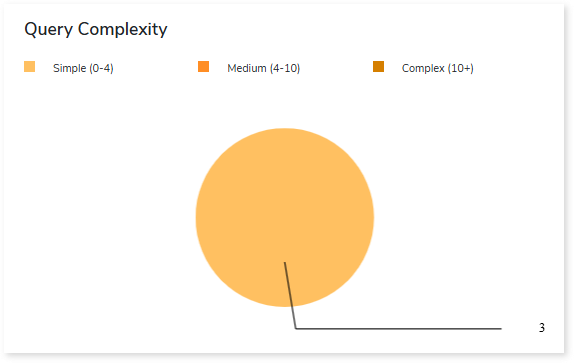
Query Database Types
This section provides an overview of different query database types within the entire inventory.
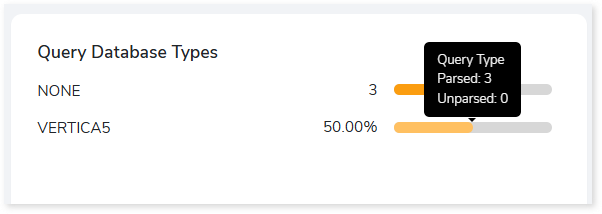
Analysis
This topic provides detailed information about the source files.
Files
This section provides a comprehensive report of the source files along with information about databases, jobs, transformations, and so on.

- File Name: Displays the name of the file.
- Database: Displays the number of associated databases.
- Jobs: Displays the number of jobs. It is a set of tasks that control the system for scheduling, monitoring, and reporting.
- Transformations: Displays the number of transformations. It is a process of moving and transforming workloads from source to target.
- Queries: Displays the number of queries.
- Complexity: Displays the file complexity.
Jobs
This section provides information about jobs, including details on components, queries, connections, job complexity, and more.

- Job Name: Displays the name of the jobs.
- Directory: Displays the directory associated with each job.
- File Name: Displays the file name associated with each job.
- Components: Displays the number of components in each job. Click the dropdown arrow next to the number of components to view the complexity of the associated components.
- Queries: Displays the number of queries in each job.
- Connections: Displays the number of connections associated with each job.
- Transformations Called: Displays the number of transformations invoked or called by each job.
- Jobs Called: Displays the number of other jobs invoked or called by each job.
- Complexity: Displays the complexity of each job.
Browse through the job to view detailed insights including all components as well as active and inactive components.
- All Components: Provides information about all components in the job.
- Active Components: Provides information about components in the job that are engaged in dataflow.
- Inactive Components: Provides information about components in the job that are not engaged in dataflow.

- Component Name: Displays the name of the components.
- Component Type: Displays the type of each component.
- Dependent Object: Displays the name of the dependent object.
- Query: Displays the query associated with each component.
- DB Type: Displays the database type of each component.
Transformation
This section provides information about transformations, including details on the number of steps, queries, connections, jobs called, complexity, and more.

- Transformation Name: Displays the name of the transformations.
- Directory: Displays the directory associated with each transformation.
- File Name: Displays the file name associated with each transformation.
- Number of Steps: Displays the number of steps in each transformation. Click the dropdown arrow next to the number of steps to view the complexity of the associated steps.
- Queries: Displays the number of queries in each transformation.
- Connections: Displays the number of connections associated with each transformation.
- Transformations Called: Displays the number of other transformations invoked or called by each transformation.
- Jobs Called: Displays the number of jobs invoked or called by each transformation.
- Complexity: Displays the complexity of each transformation.
Browse through the transformation to view detailed insights including all, active, and inactive steps.
- All Steps: Provides information about steps in the transformation.
- Active Steps: Provides information about steps in the jobs that are active in the dataflow.
- Inactive Steps: Provides information about steps in the jobs that are inactive in the dataflow.

- Step Name: Displays the name of the steps.
- Step Type: Displays the type of each step.
- Source Table: Displays the name of the source table used to read data in that step.
- Target Table: Displays the name of the target table into which the step writes the data.
- Query: Displays the query associated with each step.
- DB Type: Displays the database type of each step.
Artifacts
This page gives details about artifacts. It provides a list of missing artifacts and artifacts that appear additionally.
Missing
This section provides details of all missing artifacts. Missing artifacts are artifacts that are being used but not defined. This section also categorizes them into jobs and transformations to provide better insights.
All
This section lists all the missing artifacts.

- Artifact Name: Displays the name of the artifacts.
- Parent Name: Displays the name of the parent associated with each artifact.
- Parent Path: Displays the parent path for each artifact.
- Artifact Path: Displays the path of each artifact.
- Type: Displays the type of each artifact such as job or transformation.
Jobs
This section lists all the missing jobs.

- Artifact Name: Displays the name of the jobs.
- Parent Name: Displays the name of the parent associated with each job.
- Parent Path: Displays the parent path for each job.
- Artifact Path: Displays the path of each job.
Transformation
This section lists all the missing transformations.
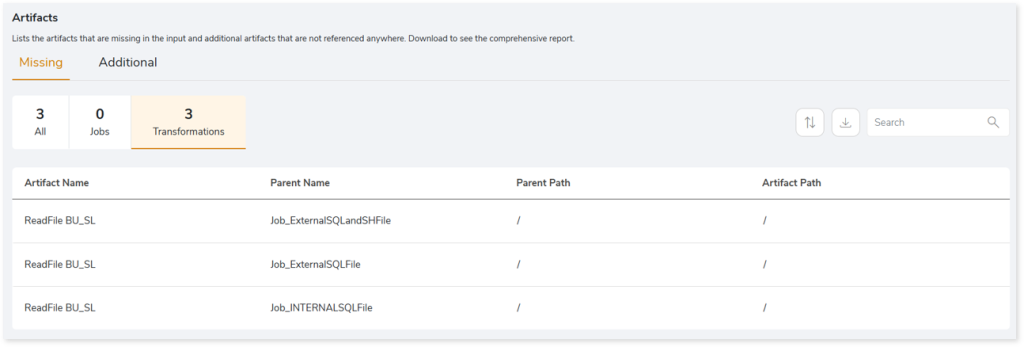
- Artifact Name: Displays the name of the transformations.
- Parent Name: Displays the name of the parent associated with each transformation.
- Parent Path: Displays the parent path for each transformation.
- Artifact Path: Displays the path of each transformation.
Additional
This section provides details of all the additional artifacts. Additional artifacts are artifacts which are provided in the input but aren’t referenced anywhere.

- Artifact Name: Displays the name of each artifact.
- File Name: Displays the file name associated with each artifact.
Downloadable Reports
Downloadable reports allow you to export detailed Pentaho assessment reports of your source data which enables you to gain in-depth insights with ease. To access these assessment reports, click Reports.

Types of Reports
In the Reports section, you can see various types of reports such as Insights and Recommendations, and Source Inventory Analysis. Each report type offers detailed information allowing you to explore your Pentaho assessment results.

Insights and Recommendations
This report provides an in-depth insight into the Pentaho source input files. It contains the final output including the details of queries, complexity, jobs, transformations, and so on.

Pentaho_Assessment_Complete_Report.xlsx: This report provides insights about the source inventory. It helps you plan the next frontier of a modern data platform methodically. It includes information about jobs, transformation, databases, and more.
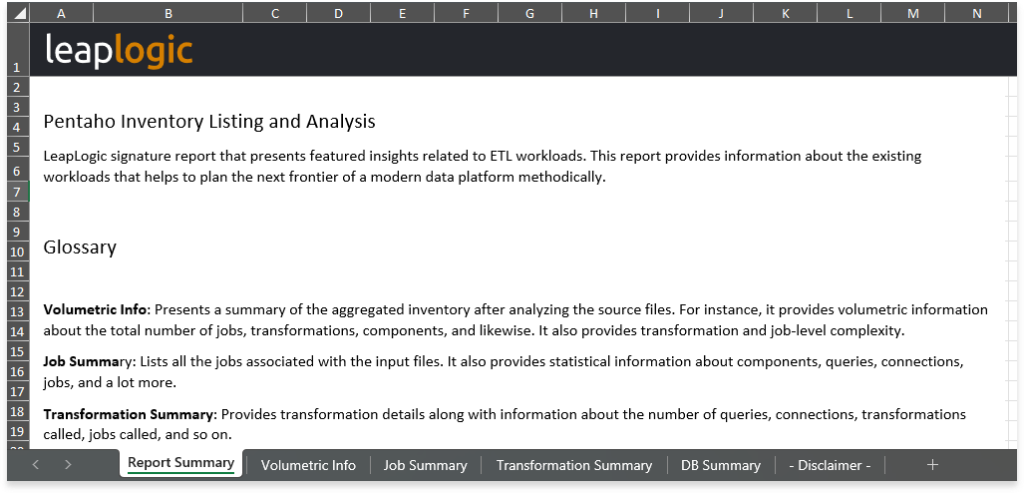
This report contains the following information:
- Report Summary: Provides information about all the generated artifacts.
- Volumetric Info: Presents a summary of the aggregated inventory after analyzing the source files. For instance, it provides volumetric information about the total number of jobs, transformations, components, and likewise. It also provides transformation and job-level complexity.
- Job Summary: Lists all the jobs associated with the input files. It also provides statistical information about components, queries, connections, jobs, and a lot more.
- Transformation Summary: Provides transformation details along with information about the number of queries, connections, transformations called, jobs called, and so on.
- DB Summary: Provides information about databases along with statistical information about jobs, transformations, and so on.
Source Inventory Analysis
It is an intermediate report which helps to debug failures or calculate the final report. It includes all the generated CSV reports.

license_quota_info.csv: This report provides information about the anticipated license quota deduction when executing a transformation pipeline or notebook using the same source input file that was used during the assessment. It includes details about the expected quota consumption for units, blocks, and scripts.
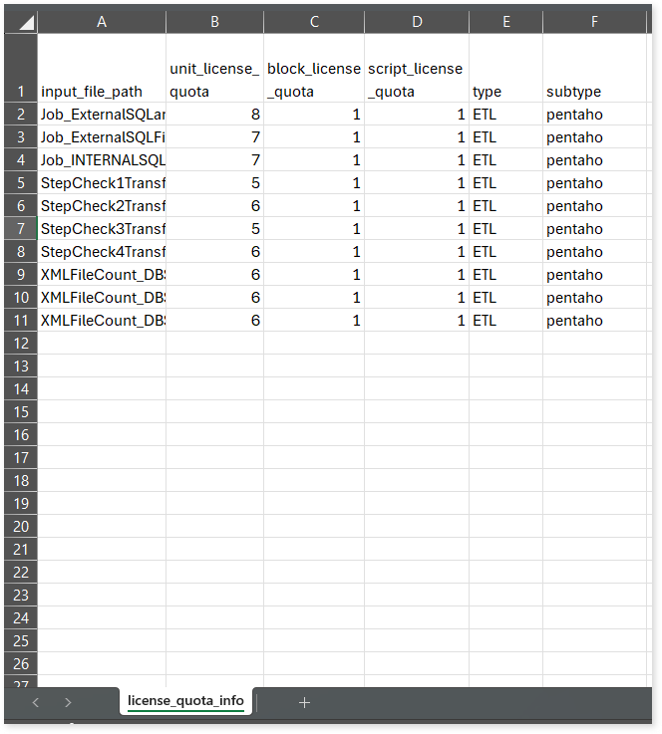
To access various outputs such as job_detail_pentaho.csv, missing_transformation_detail.csv, transformation_detail_pentaho.csv, and more, navigate through the etl > pentaho folders.

job_detail_pentaho.csv: This report provides information about jobs along with components, component types, dependent objects, queries, and more.
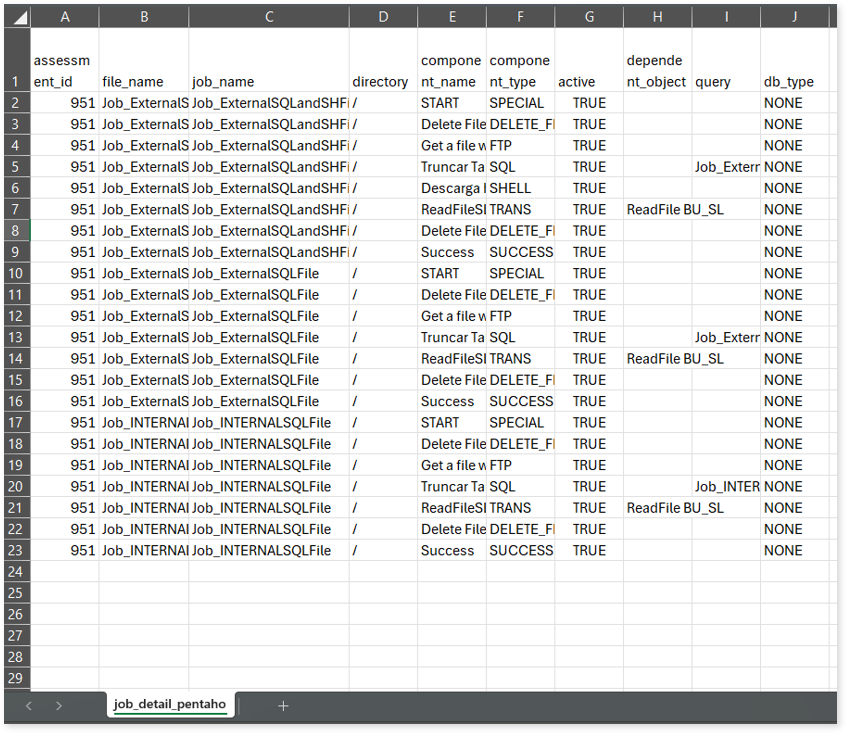
missing_transformation_detail.csv: This report provides information about missing transformations.
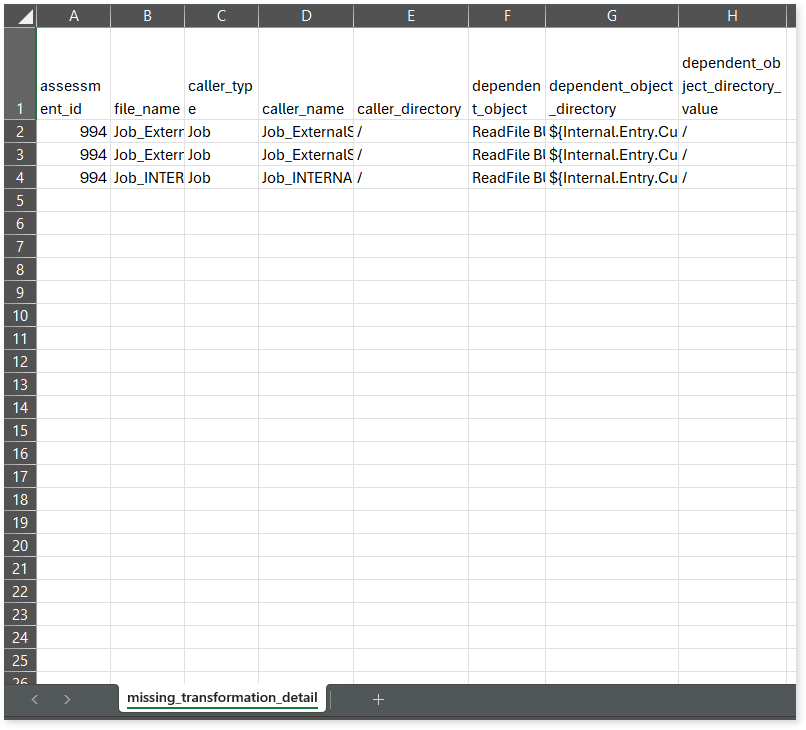
transformation_detail_pentaho.csv: This report provides information about transformations along with steps, step types, queries, and more.
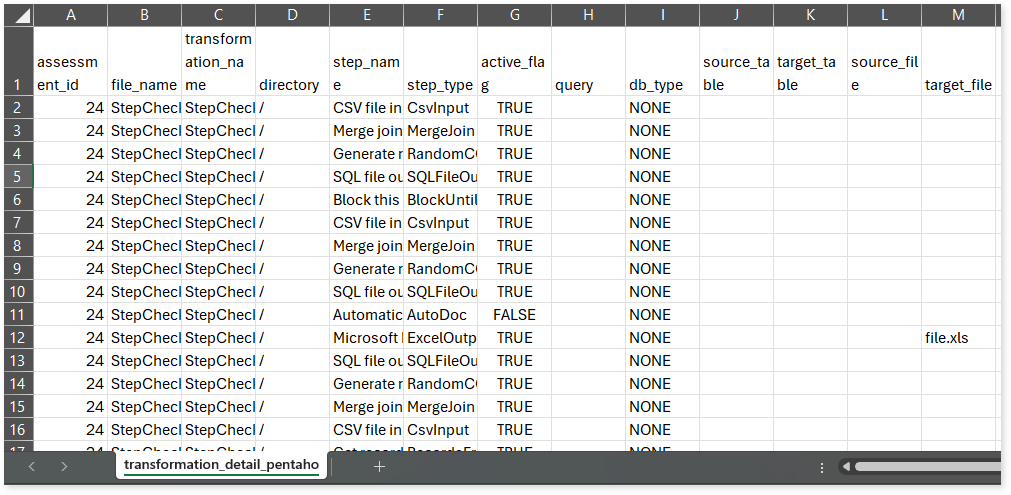
Browse through the csv folder to access the entity.csv, external_files_detail_report.csv, ExternalFiles.csv, and query_complexity.csv reports.

entity.csv: This report provides information about tables along with their type, database type, and more.
external_files_detail_report.csv: This report provides information about external files along with their type and availability.
ExternalFiles.csv: This report provides information about external files along with their type, directory, executable file path, and command.
query_complexity.csv: This report provides information about queries including analyzed status, query parsing status, complexity, and more. If the analyzed status is TRUE, it indicates that the query is analyzed successfully. Conversely, a FALSE status indicates that the query is not analyzed.
